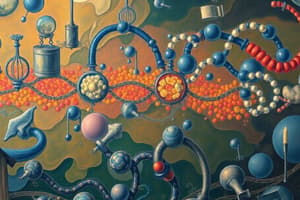Podcast
Questions and Answers
What is the main function of anabolic pathways in metabolism?
What is the main function of anabolic pathways in metabolism?
- Synthesis of complex molecules (correct)
- Breakdown of complex molecules
- Release of free energy
- Conversion of nutrients into energy
Which process is associated with catabolic pathways?
Which process is associated with catabolic pathways?
- Releasing free energy (correct)
- Building cellular structures
- Producing glucose from carbon dioxide
- Storing energy in complex forms
What defines amphibolic pathways?
What defines amphibolic pathways?
- They are exclusively catabolic.
- They link anabolic and catabolic pathways. (correct)
- They produce energy without intermediate compounds.
- They only perform anabolic reactions.
What is the primary source of carbohydrates in the diet?
What is the primary source of carbohydrates in the diet?
What is the role of salivary amylase in carbohydrate digestion?
What is the role of salivary amylase in carbohydrate digestion?
Which enzyme is responsible for the conversion of lactose into glucose and galactose?
Which enzyme is responsible for the conversion of lactose into glucose and galactose?
What does the complete oxidation of 1 gm of carbohydrates yield?
What does the complete oxidation of 1 gm of carbohydrates yield?
What is lactose intolerance caused by?
What is lactose intolerance caused by?
What is the result of lactose fermentation in the intestine?
What is the result of lactose fermentation in the intestine?
What type of metabolic pathway is glycolysis classified as?
What type of metabolic pathway is glycolysis classified as?
During glycolysis, what is produced during the energy-producing stage?
During glycolysis, what is produced during the energy-producing stage?
What is a key function of the 2,3-biphosphoglycerate produced in glycolysis?
What is a key function of the 2,3-biphosphoglycerate produced in glycolysis?
How many ATP molecules are consumed in the initial steps of glycolysis?
How many ATP molecules are consumed in the initial steps of glycolysis?
In which tissue is glycolysis especially important due to a frequent lack of oxygen?
In which tissue is glycolysis especially important due to a frequent lack of oxygen?
What are the end products of glycolysis under aerobic conditions?
What are the end products of glycolysis under aerobic conditions?
Which of the following is NOT a process included in catabolic pathways?
Which of the following is NOT a process included in catabolic pathways?
What is the net energy gain from aerobic glycolysis?
What is the net energy gain from aerobic glycolysis?
Which process yields no ATP in mature red blood cells?
Which process yields no ATP in mature red blood cells?
What effect does fructose 2,6 biphosphate have on phosphofructokinase-1 (PFK-1)?
What effect does fructose 2,6 biphosphate have on phosphofructokinase-1 (PFK-1)?
Which enzyme is not involved in the irreversible steps of glycolysis?
Which enzyme is not involved in the irreversible steps of glycolysis?
What is the role of ATP in glycolysis according to energy regulation?
What is the role of ATP in glycolysis according to energy regulation?
Which of the following enzymes is activated by fructose 1,6 biphosphate?
Which of the following enzymes is activated by fructose 1,6 biphosphate?
How does insulin primarily affect glycolysis?
How does insulin primarily affect glycolysis?
What is the result of anaerobic glycolysis in terms of ATP production?
What is the result of anaerobic glycolysis in terms of ATP production?
Flashcards
Metabolism
Metabolism
The chemical reactions inside the body that build up or break down substances.
Anabolic Pathways
Anabolic Pathways
Chemical reactions that build complex molecules from simpler ones; require energy.
Catabolic Pathways
Catabolic Pathways
Chemical reactions that break down complex molecules into simpler ones; release energy.
Amphibolic Pathways
Amphibolic Pathways
Signup and view all the flashcards
Carbohydrate Metabolism
Carbohydrate Metabolism
Signup and view all the flashcards
CHO Sources
CHO Sources
Signup and view all the flashcards
CHO Digestion
CHO Digestion
Signup and view all the flashcards
Salivary Amylase
Salivary Amylase
Signup and view all the flashcards
Pancreatic Amylase
Pancreatic Amylase
Signup and view all the flashcards
Intestinal Disaccharidases
Intestinal Disaccharidases
Signup and view all the flashcards
Lactose Intolerance
Lactose Intolerance
Signup and view all the flashcards
Lactose Intolerance
Lactose Intolerance
Signup and view all the flashcards
Intestinal Lactase Absence
Intestinal Lactase Absence
Signup and view all the flashcards
Lactose Fermentation
Lactose Fermentation
Signup and view all the flashcards
Glycolysis
Glycolysis
Signup and view all the flashcards
Aerobic Glycolysis
Aerobic Glycolysis
Signup and view all the flashcards
Anaerobic Glycolysis
Anaerobic Glycolysis
Signup and view all the flashcards
Glycolysis Location
Glycolysis Location
Signup and view all the flashcards
Glycolysis Importance
Glycolysis Importance
Signup and view all the flashcards
Substrate-Level Phosphorylation
Substrate-Level Phosphorylation
Signup and view all the flashcards
Aerobic Glycolysis ATP Gain
Aerobic Glycolysis ATP Gain
Signup and view all the flashcards
Anaerobic Glycolysis ATP Gain
Anaerobic Glycolysis ATP Gain
Signup and view all the flashcards
RBC Glycolysis
RBC Glycolysis
Signup and view all the flashcards
RBC Glycolysis End Product
RBC Glycolysis End Product
Signup and view all the flashcards
RBC Glucose Uptake
RBC Glucose Uptake
Signup and view all the flashcards
2,3-BPG
2,3-BPG
Signup and view all the flashcards
Glycolysis Key Enzymes
Glycolysis Key Enzymes
Signup and view all the flashcards
Hormonal Glycolysis Regulation
Hormonal Glycolysis Regulation
Signup and view all the flashcards
Allosteric Glycolysis Regulation
Allosteric Glycolysis Regulation
Signup and view all the flashcards
PFK-2
PFK-2
Signup and view all the flashcards
Fructose 2,6-bisphosphate
Fructose 2,6-bisphosphate
Signup and view all the flashcards
Glycolysis Inhibition (in vitro)
Glycolysis Inhibition (in vitro)
Signup and view all the flashcards
Study Notes
CHO Metabolism
- CHO metabolism involves the fate of food molecules after digestion and absorption.
- It's the chemical enzymatic reactions inside the body, concerned with synthesis and breakdown of substances.
Metabolic Pathways
- Anabolic pathways: Synthesis of complex molecules from simpler ones, requiring energy (e.g., protein synthesis).
- Catabolic pathways: Breakdown of complex molecules into simpler ones, releasing energy (e.g., oxidative processes).
- Amphibolic pathways: Link between anabolic and catabolic pathways (e.g., citric acid cycle).
Carbohydrate Metabolism
- Carbohydrates provide 50% of daily calories.
- Complete oxidation of 1 gram of carbohydrates yields 4 kcal.
- Sources of CHO in food:
- Starch (about 50%, e.g., potatoes)
- Sucrose and lactose
- Fructose and glucose (fruits, honey)
CHO Digestion
- Polysaccharides and disaccharides must be converted to monosaccharides for absorption.
- Enzymes involved:
- Salivary amylase: Converts starch and glycogen into dextrins.
- Pancreatic amylase: Converts dextrins into maltose.
- Intestinal disaccharidases:
- Maltase: Converts maltose into 2 glucose molecules.
- Sucrase: Converts sucrose into glucose and fructose.
- Lactase: Converts lactose into glucose and galactose.
Lactose Intolerance
- Definition: A disease (congenital or acquired), caused by lactase enzyme deficiency.
- Effects: Undigested lactose accumulates in the intestines, leading to bacterial fermentation, producing acids and gases.
- Symptoms: Abdominal distension, cramps, diarrhea.
- Treatment: Lactose-free milk formula.
Metabolic Pathways of Carbohydrates
- Catabolic pathways: Glycolysis, pentose phosphate shunt (Uronic acid), and glycogenolysis.
- Anabolic pathways: Gluconeogenesis and glycogenesis.
- Amphibolic pathways: Citric acid cycle.
Glycolysis
- Definition: Oxidation of glucose to pyruvate (with oxygen) or lactate (without oxygen).
- Major pathway for glucose oxidation.
- Location: Cytoplasm of all tissue cells.
- Importance in specific tissues: Tissues without mitochondria (RBCs, cornea, lens). Tissues with frequent oxygen lack (skeletal muscles).
- Stages:
- Stage 1: Energy-requiring stage: Converts glucose into glyceraldehyde-3-P (needs energy).
- Stage 2: Energy-producing stage: Converts glyceraldehyde-3-P to pyruvate or lactate (produces energy).
Importance of Glycolysis
- Energy production: Anaerobic glycolysis (2 ATP), aerobic glycolysis (6-8 ATP).
- Metabolism of fructose and galactose.
- Good oxygenation of tissues: 2,3 biphosphoglycerate decreases Hb's affinity for oxygen.
- Provides important intermediates: (e.g., glycerol-3-P for lipogenesis, pyruvate for alanine amino acid synthesis.)
Energy Production of Glycolysis
- ATP consumption (both aerobic and anaerobic glycolysis): Glucose to G-6-P (1 ATP). Fructose-6-P to fructose 1,6 biphosphate (1 ATP). Net energy consumed = 2 ATP.
- ATP production (Aerobic glycolysis):
- 4 ATP by substrate level phosphorylation.
- 4 or 6 ATP from oxidative phosphorylation of 2 NADH+H+ by respiratory chain.
- Net energy gain (Aerobic): 8-10 ATP.
- Net energy gain (Anaerobic): 2 ATP.
Substrate-Level Phosphorylation
- Definition: Phosphorylation of ADP to ATP at the level of the reaction itself, without the respiratory chain.
- Example: 1,3 biphosphoglycerate + ADP → 3 phosphoglycerate + ATP
Glycolysis in Red Blood Cells (RBCs)
- Mature RBCs lack mitochondria, relying entirely on glycolysis for energy.
- Lactate is the end product.
- Net energy yield = 2 ATP.
- Glucose uptake doesn't depend on insulin.
- 2,3 biphosphoglycerate production.
Regulation of Glycolysis
- Key enzymes: Hexokinase/glucokinase, Phosphofructokinase-1 (PFK-1), Pyruvate kinase.
- Hormonal regulation: Insulin stimulates enzyme synthesis, glucagon inhibits.
- Allosteric regulation:
- G-6-P inhibits hexokinase (not glucokinase)
- Fructose-2,6-biphosphate stimulates PFK-1 and pyruvate kinase.
- Citrate inhibits PFK-1.
- Covalent modification: Pyruvate kinase inactivated by phosphorylation.
- Energy regulation: ATP and AMP effects on PFK-1 and pyruvate kinase
In Vitro Inhibition of Glycolysis
- Inhibitors:
- Arsenate: Competes with inorganic phosphate in Glyceraldehyde-3-P reaction.
- Iodoacetate: Inhibits Glyceraldehyde-3-P dehydrogenase.
- Fluoride: Inhibits enolase.
- Clinical relevance: Hemolytic anemia can result from impaired glycolysis (specifically pyruvate kinase deficiency) in RBCs.
Studying That Suits You
Use AI to generate personalized quizzes and flashcards to suit your learning preferences.



